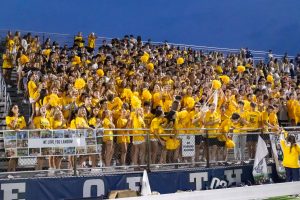Metropolitan Community Project invites two high schools to talk about equal education
Kelvyn Park and NT students discuss unequal education in Chicagoland schools
December 22, 2017
On Thursday Dec. 14, New Trier’s Social Service Board hosted a group of students from Kelvyn Park High School as part of a partnership between the two schools called The Metropolitan Community Project.
The program, which takes place over the course of several months, consists of students visiting each other’s schools and discussing the disparities in resources, opportunities, and facilities, and culminates in action based on what they’ve learned.
According to the Illinois Report Card released by the Illinois School Board of Education, Kelvyn Park spends around $11,000 on instructional expenses per student, while New Trier spends $23,000.
This is attributed to the difference in funding each school receives: Kelvyn Park’s finances are comprised of 15% federal funding, 30% state funding, and 55% local funding, whereas New Trier’s is 2% federal, 2% state, and 96% local.
Nancy Manuel, a sophomore at Kelvyn Park, participated in the event on Thursday.
She noted a difference in the schools including the variety of classes and foods. “You guys have so many choices,” she said. “We don’t have as many things but we do have connections with our teachers.”
Kelvyn Park only has AP, Honors, Regular, and Dual Credit classes.
Manuel also mentioned how parts of the program can feel intimidating, but also how much she’s learned about communication through it.
“I was surprised by how many things we have in common. I love getting to see the differences, not only between the schools but between the people as well.”
On Oct. 26 New Trier met with Kelvyn Park in a neutral location, Northeastern Illinois University, where students went on a scavenger hunt and watched a presentation on how Illinois schools are funded.
The two schools met again Nov. 30 at Kelvyn Park High School, where the students participated in icebreaker activities, continued the discourse on funding disparity, and the New Trier students were given a tour of the school.
Last week, the meeting at New Trier started with an icebreaker and an activity where the students split into groups and discussed what their perfect schools would be like.
Specifically, the students discussed whether or not it would make a difference if Kelvyn Park students suddenly had all the resources available to us here.
President of Social Service Board and project member, Brian Butler, said, “We will have one or two days in 2018 where we will discuss further and make plans to take action against the inequity. We will meet with Illinois legislators and possibly march in Springfield.”
In the past, the project has culminated in similar meetings with various state legislatures including Daniel Biss, Elaine Nekritz, Will Guzzardi, Greg Harris, Melinda Bush, and Pamela Althoff to discuss more equitable funding models for Illinois schools.
The 2014 year ended with an Action Day on May 9, where students from all participating schools shared personal stories of their educational experiences and presented an Illinois Student Bill of Rights to teachers, families, legislators and the press.
Last year, both schools met with legislators during a fourth meeting and met again to share experiences at a fifth meeting.
A few students from New Trier and Kelvyn Park also went to Springfield to support a bill that would change the formula for school funding.
Jose Florentino, a Kelvyn Park senior who participated in the program last year and is involved in various other community organizing efforts on top of this, said he’d highly recommend the program to any student.
“It’s making a difference by bringing awareness to an issue that is often overlooked,” he said.
Florentino also noted that while this awareness is important, “In order for us to make a real change, we need to win over the representatives.”













































